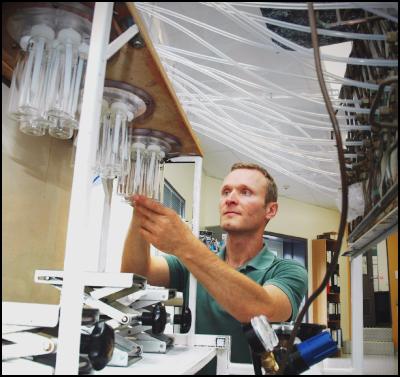Lower Hutt Lab Comes Out Top Of The World
Lower Hutt Lab Comes Out Top Of The World

Scientist Uwe Morgenstern prepares equipment to determine the age of a batch of water samples. The laboratory he manages produces the most accurate water dating measurements in the world.
Our national sporting teams may have had a patchy year, but New Zealand scientists have done their bit to put the country on the international map.
A water dating laboratory operated by GNS Science has come out top in an accuracy test in which 70 water dating laboratories around the world participated.
The GNS Science Tritium and Water Dating Laboratory has shown itself to be four times more accurate than the second-placed laboratory in the international comparison. The inter-laboratory comparison has been run every four or five years by the International Atomic Energy Agency since 1965. Results from the most recent comparison have just been released.
Tritium is a rare isotope of hydrogen that occurs naturally in rainwater and snow. With a half-life of 12.3 years, it can be used to find out when water fell to earth as either rain or snow.
Tritium dating is a valuable tool in understanding the dynamics of groundwater, glaciers, and lakes. Knowing the age of groundwater helps in managing aquifers effectively. Water age also indicates if groundwater is free of pathogens and therefore safe for drinking. Another area where water dating is important is in understanding and managing nitrification of lakes such as Rotorua and Taupo.
Age-dating by the tritium method is based on measuring the portion of tritium that has decayed to helium-3, another rare isotope that occurs in water. Tritium concentrations start to decrease as soon as rain penetrates the ground.
Each of the 70 participating laboratories was asked to measure tritium concentrations in six blind water samples. The GNS Science Laboratory was the only lab to get all six samples right.
Manager of the GNS Science Laboratory, Uwe Morgenstern, said the result was very gratifying and would help in securing more business, especially from overseas.
“ We can now say unequivocally that we are the most accurate tritium dating lab in the world. That will help considerably in attracting new business, especially from Europe and North America,” Dr Morgenstern said. About 70 percent of the Laboratory’s business currently comes from overseas.
The Laboratory’s measurements have been adopted by New Zealand government policy-makers as a benchmark for the security of drinking water from aquifers. New Zealand is believed to be the only country in the world where tritium measurements are included in government environmental policy.
ENDS


 Business Canterbury: Urges Council To Cut Costs, Not Ambition For City
Business Canterbury: Urges Council To Cut Costs, Not Ambition For City Wellington Airport: On Track For Net Zero Emissions By 2028
Wellington Airport: On Track For Net Zero Emissions By 2028 Landcare Research: ANZAC Gall Fly Release Promises Natural Solution To Weed Threat
Landcare Research: ANZAC Gall Fly Release Promises Natural Solution To Weed Threat NZ Anti-Vivisection Society: Auckland Rat Lovers Unite!
NZ Anti-Vivisection Society: Auckland Rat Lovers Unite! University of Canterbury: $1.35 Million Grant To Study Lion-like Jumping Spiders
University of Canterbury: $1.35 Million Grant To Study Lion-like Jumping Spiders Federated Farmers: Government Ends War On Farming
Federated Farmers: Government Ends War On Farming



